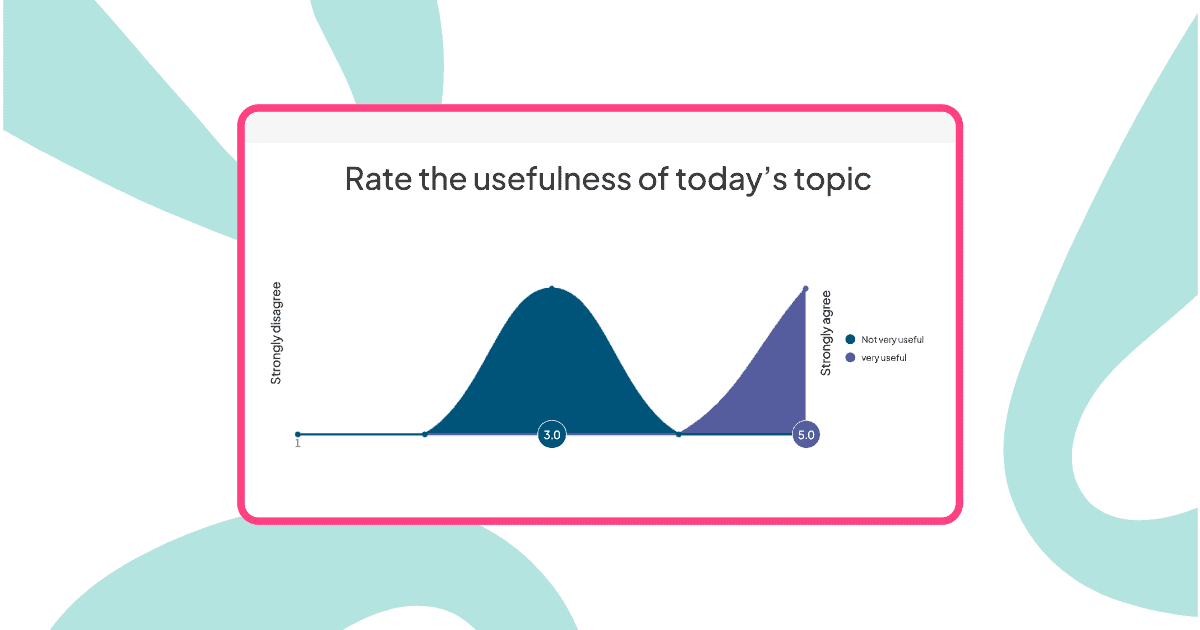Sizning xodimlaringiz o'zlarining rollari, hissalari va umumiy ishdan qoniqishlari haqida haqiqatan ham qanday his qilishlari haqida hech o'ylab ko'rganmisiz?
Muvaffaqiyatli martaba endi oy oxiridagi ish haqi bilan cheklanmaydi. Masofaviy ish, moslashuvchan soatlar va o'zgaruvchan ish rollari davrida ishdan qoniqish ta'rifi keskin o'zgardi.
Muammo shundaki: an'anaviy yillik so'rovlar ko'pincha past javob stavkalari, kechiktirilgan tushunchalar va tozalangan javoblarni beradi. Xodimlar ularni yolg'iz o'z stollarida to'ldiradilar, bir lahzadan uzilib qolgan va kimligini aniqlashdan qo'rqishadi. Natijalarni tahlil qilganingizda, muammolar yoki kuchayib ketgan yoki unutilgan.
Buning yaxshiroq yo'li bor. Jamoa yig'ilishlari, shahar zallari yoki o'quv mashg'ulotlari davomida o'tkazilgan interaktiv ishdan qoniqish so'rovlari haqiqiy fikr-mulohazalarni o'z ichiga oladi, bu vaqtda - faollik eng yuqori bo'lgan va siz real vaqt rejimida tashvishlarni hal qilishingiz mumkin.
Ushbu qo'llanmada biz taqdim etamiz Sizning ishingizdan qoniqish so'rovi uchun 46 ta namunali savollar, sizga qanday qilib statik soʻrovlarni qiziqarli suhbatlarga aylantirishni koʻrsating va xodimlarning faolligini rivojlantiruvchi, innovatsiyalarni qoʻzgʻatuvchi va doimiy muvaffaqiyat uchun zamin yaratadigan ish joyi madaniyatini rivojlantirishga yordam beradi.
Mundarija
- Ishdan qoniqish so'rovi nima?
- Nima uchun ishdan qoniqish so'rovini o'tkazish kerak?
- An'anaviy va interaktiv so'rovlar o'rtasidagi farq
- 46 Ishdan qoniqish anketasi uchun namunali savollar
- AhaSlides bilan samarali ishdan qoniqish so'rovini qanday o'tkazish kerak
- Nima uchun interaktiv so'rovlar an'anaviy shakllarga qaraganda yaxshiroq ishlaydi
- Key Takeaways
Ishdan qoniqish so'rovi nima?
Ishdan qoniqish so'rovi, shuningdek, xodimlarning qoniqish so'rovi sifatida ham tanilgan, kadrlar bo'yicha mutaxassislar va tashkilot rahbarlari o'z xodimlarining o'z vazifalarini qanchalik bajarayotganini tushunish uchun foydalanadigan strategik vositadir.
U ish muhiti, ish majburiyatlari, hamkasblar va rahbarlar bilan munosabatlar, tovon puli, o'sish imkoniyatlari, farovonlik va boshqalarni o'z ichiga olgan muhim sohalarni qamrab olish uchun puxta ishlab chiqilgan savollardan iborat.
An'anaviy yondashuv: So'rovnoma havolasini yuboring, javoblar kelishini kuting, bir necha haftadan so'ng ma'lumotlarni tahlil qiling, so'ngra asl tashvishlardan uzilib qolgan o'zgarishlarni amalga oshiring.
Interaktiv yondashuv: Uchrashuvlar davomida savollarni jonli ravishda taqdim eting, anonim so'rovlar va so'z bulutlari orqali darhol fikr-mulohazalarni to'plang, natijalarni real vaqtda muhokama qiling va suhbat yangi bo'lsa-da, birgalikda yechimlarni ishlab chiqing.
Nima uchun ishdan qoniqish so'rovini o'tkazish kerak?
Pew tadqiqoti O'z-o'zini ish bilan band bo'lmagan ishchilarning qariyb 39 foizi o'z ish joylarini o'zlarining umumiy shaxsiyati uchun muhim deb bilishini ta'kidlaydi. Bu hissiyot oilaning daromadi va ta'limi kabi omillarga bog'liq bo'lib, yuqori daromadlilarning 47 foizi va aspirantlarning 53 foizi o'zlarining ish o'ziga xosligiga ahamiyat berishadi. Ushbu o'zaro ta'sir xodimlarning qoniqishi uchun muhim ahamiyatga ega bo'lib, maqsad va farovonlikni oshirish uchun yaxshi tuzilgan ishdan qoniqish so'rovini zarur qiladi.
Ishdan qoniqish so'rovini o'tkazish ham xodimlar, ham tashkilot uchun katta afzalliklarni beradi:
Aniq tushuncha
Muayyan savollar xodimlarning haqiqiy his-tuyg'ularini, fikrlarini, tashvishlarini va qoniqish sohalarini ochib beradi. Anonim javob variantlari bilan interaktiv tarzda o'tkazilganda, siz an'anaviy so'rovlarda ko'pincha insofsiz fikr-mulohazalarga olib keladigan identifikatsiya qo'rquvini chetlab o'tasiz.
Muammoni aniqlash
Maqsadli so'rovlar ma'naviyat va faollikka ta'sir qiluvchi og'riqli nuqtalarni aniqlaydi - aloqa, ish yuki yoki o'sish imkoniyatlari bilan bog'liq. Haqiqiy vaqtda so'z bulutlari ko'pchilik xodimlar qayerda kurashayotganini darhol tasavvur qilishlari mumkin.
Moslashtirilgan yechimlar
Yigʻilgan maʼlumotlar ish sharoitlarini yaxshilashga sodiqligingizni koʻrsatib, moslashtirilgan yechimlarni ishlab chiqish imkonini beradi. Xodimlar o'zlarining fikr-mulohazalarini darhol ko'rsatilishi va ochiq muhokama qilinishini ko'rganlarida, ular shunchaki so'rovdan o'tgandan ko'ra, chinakam eshitilgandek his qilishadi.
Kengaytirilgan jalb qilish va saqlash
Anketa natijalariga ko'ra tashvishlarni hal qilish ishtirok etishni oshiradi, aylanmani pasaytirishga va sodiqlikni oshirishga yordam beradi. Interaktiv so'rovlar byurokratik mashg'ulotdan olingan fikr-mulohazalarni to'plashni mazmunli suhbatga aylantiradi.
An'anaviy va interaktiv so'rovlar o'rtasidagi farq
| Aspect | An'anaviy so'rov | Interaktiv so'rov (AhaSlides) |
|---|---|---|
| Xronologiya | Elektron pochta orqali yuborilgan, yolg'iz to'ldirilgan | Uchrashuvlar davomida jonli ravishda olib borildi |
| Javob yedi | O'rtacha 30-40% | Jonli ravishda taqdim etilganda 85-95% |
| Anonimlik | Shubhali - xodimlar kuzatuvdan xavotirda | Kirish talab qilinmaydigan haqiqiy anonimlik |
| unashtirish | Uy vazifasi kabi | Suhbat kabi |
| natijalar | Kunlar yoki haftalar keyin | Tezkor, real vaqtda vizualizatsiya |
| harakat | Kechiktirilgan, uzilgan | Darhol muhokama va yechimlar |
| format | Statik shakllar | Dinamik so‘rovlar, so‘z bulutlari, savol-javoblar, reytinglar |
Asosiy tushuncha: Fikr-mulohaza hujjatlarga emas, balki suhbatga o'xshasa, odamlar ko'proq ishtirok etadilar.
46 Ishdan qoniqish anketasi uchun namunali savollar
Bu erda toifalar bo'yicha tuzilgan savollar namunalari. Har bir bo'limda maksimal halollik va ishtirok etish uchun ularni interaktiv tarzda taqdim etish bo'yicha ko'rsatmalar mavjud.
Ish muhiti
savollar:
- Ish joyingizning jismoniy qulayligi va xavfsizligini qanday baholaysiz?
- Ish joyining tozaligi va tartibliligi sizni qoniqtirdimi?
- Sizningcha, ofis muhiti ijobiy ish madaniyatini rivojlantiradimi?
- Ishingizni samarali bajarish uchun zarur vositalar va resurslar bilan ta'minlanganmisiz?
AhaSlides bilan interaktiv yondashuv:
- Jonli efirda ko'rsatilgan reyting shkalasidan foydalaning (1-5 yulduz).
- Ochiq so'z buluti bilan kuzatib boring: "Bir so'z bilan bizning ish joyimizni tasvirlab bering"
- Anonim rejimni yoqing, shunda xodimlar qo'rqmasdan jismoniy sharoitlarni halol baholaydilar
- Muhokama boshlash uchun jamlangan natijalarni darhol ko'rsating
Nima uchun bu ishlaydi: Xodimlar boshqalarning o'xshash xavotirlarini ko'rganlarida (masalan, bir nechta odamlar "asboblar va resurslar" ni 2/5 deb baholaydilar), ular o'zlarini tasdiqlangan va keyingi savol-javob sessiyalarida batafsilroq ma'lumot berishga tayyor his qilishadi.
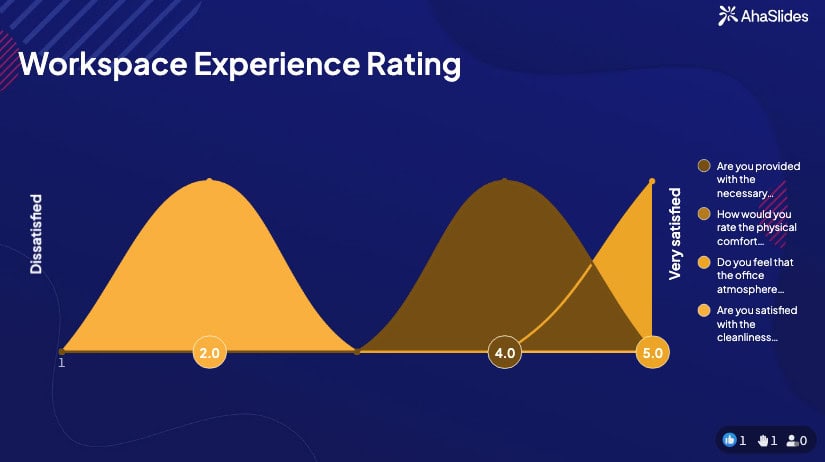
Ish joyidagi muhit so‘rovi shablonini sinab ko‘ring →
Lavozimiy vazifalari
savollar:
- Sizning hozirgi ish majburiyatlaringiz sizning malakangiz va malakangizga mos keladimi?
- Sizning vazifalaringiz aniq belgilab qo'yilganmi va sizga e'lon qilinganmi?
- Sizda yangi qiyinchiliklarga duch kelish va mahoratingizni kengaytirish imkoniyati bormi?
- Kundalik vazifalaringizning xilma-xilligi va murakkabligi sizni qoniqtiradimi?
- Sizning ishingiz maqsad va amalga oshirish hissi bilan ta'minlaydi deb o'ylaysizmi?
- Rolingizda qaror qabul qilish vakolatingiz darajasi sizni qoniqtiradimi?
- Sizning vazifangiz tashkilotning umumiy maqsadlari va missiyasiga mos kelishiga ishonasizmi?
- Ish vazifalaringiz va loyihalaringiz uchun sizga aniq ko'rsatmalar va taxminlar taqdim etilganmi?
- Sizning ish mas'uliyatingiz kompaniya muvaffaqiyati va o'sishiga hissa qo'shishini qanchalik yaxshi his qilasiz?
AhaSlides bilan interaktiv yondashuv:
- Aniqlik uchun savollar uchun ha/yo‘q so‘rovlarini taqdim eting (masalan, “Sizning vazifalaringiz aniq belgilanganmi?”)
- Qoniqish darajasi uchun reyting shkalasidan foydalaning
- Ochiq savol-javob bilan kuzatib boring: "Siz qanday mas'uliyatni qo'shmoqchisiz yoki olib tashlamoqchisiz?"
- So'z bulutini yarating: "O'z rolingizni uchta so'z bilan tavsiflang"
Pro Maslahat: Anonim savol-javob xususiyati bu erda ayniqsa kuchli. Xodimlar "Nega qaror qabul qilishda ko'proq avtonomiyaga ega emasmiz?" kabi savollarni yuborishlari mumkin. aniqlanishidan qo‘rqmasdan, menejerlarga tizimli masalalarni ochiq hal qilish imkonini beradi.
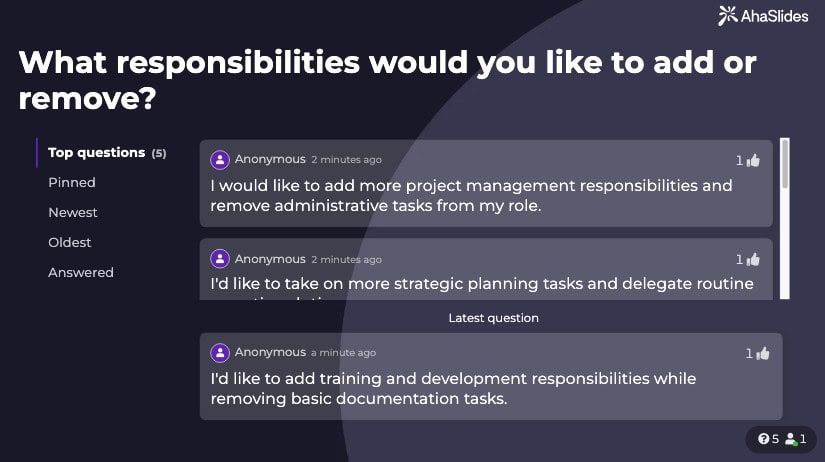
Nazorat va etakchilik
savollar:
- Siz va rahbaringiz o'rtasidagi muloqot sifatini qanday baholaysiz?
- Sizning ishlashingiz bo'yicha konstruktiv fikr-mulohazalar va ko'rsatmalar olasizmi?
- O'z fikr va takliflaringizni rahbaringizga bildirishingiz tavsiya qilinadimi?
- Rahbaringiz sizning hissalaringizni qadrlashini va harakatlaringizni tan olishini his qilyapsizmi?
- Sizning bo'limingizdagi etakchilik uslubi va boshqaruv yondashuvidan qoniqasizmi?
- Sizning fikringizcha, etakchilik qobiliyatlarining qaysi turlari jamoangizda samaraliroq bo'ladi?
AhaSlides bilan interaktiv yondashuv:
- Nozik nazoratchi fikr-mulohazalari uchun anonim reyting shkalalaridan foydalaning
- Rahbarlik uslubi variantlarini taqdim eting (demokratik, murabbiylik, transformatsion va boshqalar) va qaysi xodimlarni afzal ko'rishini so'rang.
- Xodimlar boshqaruv yondashuvi haqida savollar berishlari mumkin bo‘lgan jonli savol-javobni yoqing
- Reytinglarni yarating: "Nazoratchida siz uchun eng muhimi nima?" (Aloqa, tan olish, fikr-mulohaza, avtonomiya, qo'llab-quvvatlash)
Nima uchun anonimlik muhim: Joylashuv ish varaqingizga ko'ra, HR mutaxassislari "halol muhokama qilish uchun xavfsiz joylarni yaratishlari" kerak. Shahar zallaridagi interaktiv anonim so'rovlar xodimlarga mansab tashvishlarisiz etakchilikni halol baholash imkonini beradi - an'anaviy so'rovlar ishonchli tarzda erishish uchun kurashadi.
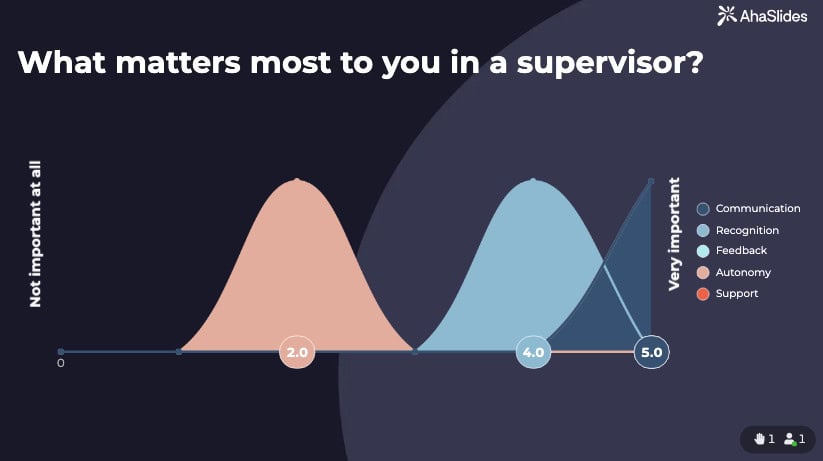
Karyera o'sishi va rivojlanishi
savollar:
- Sizga kasbiy o'sish va yuksalish uchun imkoniyatlar yaratilganmi?
- Tashkilot taklif qilayotgan oʻquv va rivojlanish dasturlari sizni qanchalik qoniqtirdi?
- Sizning hozirgi rolingiz uzoq muddatli martaba maqsadlaringizga mos kelishiga ishonasizmi?
- Sizga etakchilik rollarini yoki maxsus loyihalarni bajarish imkoniyati beriladimi?
- Qo'shimcha ma'lumot olish yoki malaka oshirish uchun yordam olasizmi?
AhaSlides bilan interaktiv yondashuv:
- So'rov: "Qaysi kasbiy rivojlanish sizga ko'proq foyda keltiradi?" (Etakchilik treningi, texnik ko'nikmalar, sertifikatlar, murabbiylik, lateral harakatlar)
- So'z buluti: "3 yildan keyin o'zingizni qayerda ko'rasiz?"
- Baholash shkalasi: "Karyerangizni rivojlantirishda o'zingizni qanday qo'llab-quvvatlaysiz?" (1-10)
- Muayyan rivojlanish imkoniyatlari haqida so'rash uchun xodimlarga savol-javoblarni oching
Strategik ustunlik: Ushbu ma'lumotlar jadvalda aks ettirilgan an'anaviy so'rovlardan farqli o'laroq, har chorakda bir marta ko'rib chiqilayotganda martaba rivojlanishiga oid savollarni jonli ravishda taqdim etish HRga suhbat faol bo'lgan vaqtda o'quv byudjetlari, murabbiylik dasturlari va ichki harakatchanlik imkoniyatlarini darhol muhokama qilish imkonini beradi.
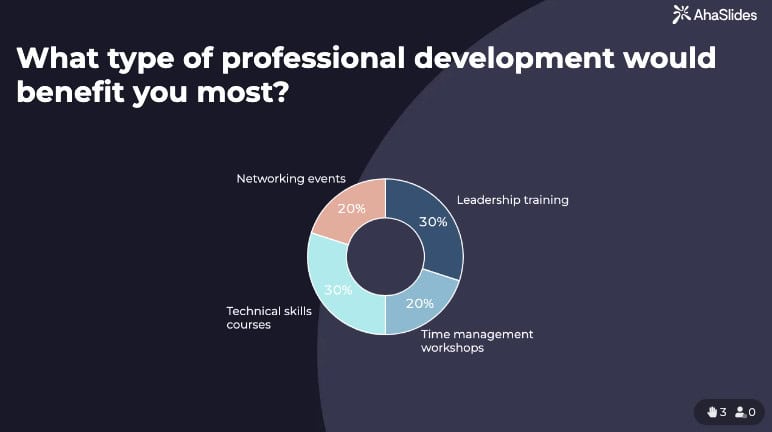
Kompensatsiya va imtiyozlar
savollar:
- Joriy maoshingiz va kompensatsiya paketingiz, shu jumladan qo'shimcha imtiyozlar sizni qoniqtiradimi?
- Sizning hissalaringiz va yutuqlaringiz munosib taqdirlanganini his qilyapsizmi?
- Tashkilot tomonidan taqdim etilayotgan imtiyozlar har tomonlama va ehtiyojlaringizga mosmi?
- Ish faoliyatini baholash va kompensatsiya jarayonining shaffofligi va adolatliligini qanday baholaysiz?
- Bonuslar, rag'batlantirishlar yoki mukofotlar imkoniyatlaridan qoniqasizmi?
- Yillik ta'til siyosatidan qoniqasizmi?
AhaSlides bilan interaktiv yondashuv:
- Nozik ish haqi savollari uchun anonim ha/yo'q so'rovlari
- Ko'p tanlov: "Siz uchun qaysi imtiyozlar muhimroq?" (Sog'liqni saqlash, moslashuvchanlik, o'quv byudjeti, sog'lomlashtirish dasturlari, pensiya)
- Baho shkalasi: "Sizning hissangizga nisbatan bizning tovonimiz qanchalik adolatli?"
- So'z buluti: "Qaysi foyda sizning qoniqishingizni ko'proq oshiradi?"
Tanqidiy eslatma: Bu erda anonim interaktiv so'rovlar haqiqatan ham porlaydi. Kirish ma'lumotlarini talab qiladigan an'anaviy so'rovlarda xodimlar kamdan-kam hollarda halol tovon haqida fikr bildiradilar. Javoblar nomsiz ko'rinadigan shahar zallarida jonli anonim so'rovlar haqiqiy fikr-mulohaza uchun psixologik xavfsizlikni yaratadi.
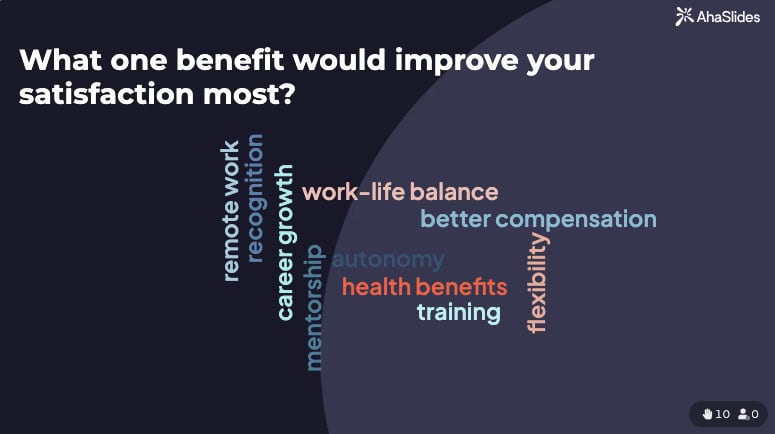
Kompensatsiya haqida fikr-mulohaza seansini yarating →
Aloqalar va hamkorlik
savollar:
- Siz hamkasblaringiz bilan qanchalik yaxshi hamkorlik qilasiz va muloqot qilasiz?
- Sizning bo'limingizda do'stlik va jamoaviy ish tuyg'usini his qilyapsizmi?
- Tengdoshlaringiz o'rtasidagi hurmat va hamkorlik darajasidan qoniqasizmi?
- Turli bo'limlar yoki jamoalardagi hamkasblar bilan muloqot qilish imkoniyati bormi?
- Zarur bo'lganda hamkasblaringizdan yordam yoki maslahat so'rash sizga qulaymi?
AhaSlides bilan interaktiv yondashuv:
- Hamkorlik sifati uchun reyting shkalasi
- So'z buluti: "Jamoamiz madaniyatini bir so'z bilan ta'riflang"
- Ko'p tanlov: "Siz bo'limlar bo'ylab qanchalik tez-tez hamkorlik qilasiz?" (Kundalik, haftalik, oylik, kamdan-kam hollarda, hech qachon)
- Shaxslararo muammolarni yuzaga chiqarish uchun anonim savol-javob
Farovonlik va ish-hayot muvozanati
savollar:
- Tashkilot tomonidan taqdim etilgan ish va hayot muvozanatidan qanchalik qoniqasiz?
- Stressni boshqarish va ruhiy farovonligingizni saqlab qolishda kompaniya tomonidan yetarli darajada qo‘llab-quvvatlanayotganini his qilyapsizmi?
- Shaxsiy yoki ish bilan bog'liq muammolarni hal qilish uchun yordam yoki manba izlashga qulaymisiz?
- Siz qanchalik tez-tez sog'lomlashtirish dasturlari yoki tashkilot tomonidan taqdim etilgan tadbirlarda qatnashasiz?
- Sizningcha, kompaniya o'z xodimlarining farovonligini qadrlaydi va birinchi o'ringa qo'yadi?
- Siz qulaylik, yorug'lik va ergonomika nuqtai nazaridan jismoniy ish muhitidan qoniqasizmi?
- Tashkilot sizning salomatlik va farovonlik ehtiyojlaringizga qanchalik mos keladi (masalan, moslashuvchan ish soatlari, masofaviy ish imkoniyatlari)?
- Zaryad bo'lganda tanaffuslar qilish va ishdan bo'shatish sizni rag'batlantiradimi?
- Ish bilan bog'liq omillar tufayli qanchalik tez-tez o'zingizni haddan tashqari ko'tarasiz yoki stressni his qilasiz?
- Tashkilot tomonidan taqdim etilayotgan salomatlik va salomatlik imtiyozlaridan qoniqasizmi?
AhaSlides bilan interaktiv yondashuv:
- Chastotalar shkalasi: "Siz qanchalik tez-tez stressni his qilasiz?" (Hech qachon, kamdan-kam, ba'zan, tez-tez, har doim)
- Farovonlikni qo'llab-quvvatlash bo'yicha so'rovnomalar ha/yo'q
- Anonim slayder: "Joriy charchash darajangizni baholang" (1-10)
- So'z buluti: "Sizning farovonligingizni nima yaxshilaydi?"
- Xodimlar farovonlik tashvishlarini anonim ravishda baham ko'rishlari uchun savol-javoblarni oching
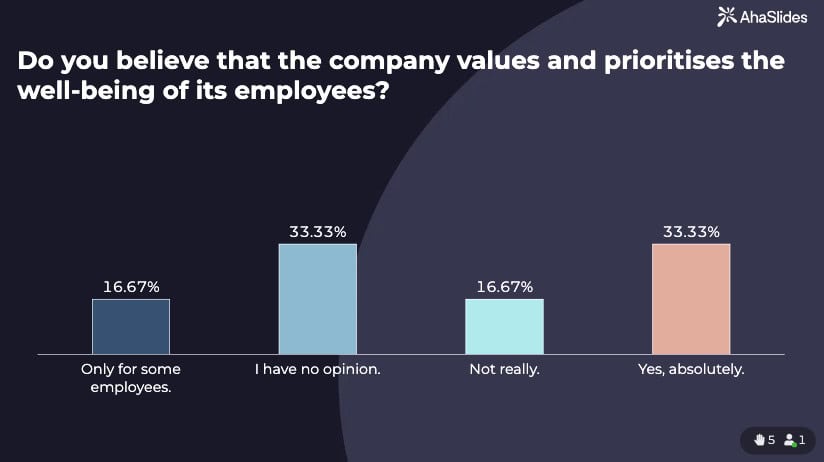
Nima uchun bu muhim? Sizning joylashuvingiz bo'yicha ishchi varaqingizda HR mutaxassislari "xodimlarni jalb qilish va fikr-mulohazalar" va "halol muhokama qilish uchun xavfsiz joylar yaratish" bilan kurashayotganini aniqlaydi. Sog'lomlik savollari tabiatan nozikdir - xodimlar charchaganliklarini tan olishsa, kuchsiz yoki o'zini himoya qilmaslikdan qo'rqishadi. Interaktiv anonim so'rovlar bu to'siqni olib tashlaydi.
Umumiy qoniqish
Yakuniy savol: 46. 1-10 shkala bo'yicha, siz ushbu kompaniyani ishlash uchun ajoyib joy sifatida tavsiya qilish ehtimoli qanchalik katta? (Xodimlarning aniq promouter balli)
Interaktiv yondashuv:
- Natijalar asosida kuzatib boring: Agar ballar past boʻlsa, darhol “Baholaringizni yaxshilash uchun nimani oʻzgartirishimiz mumkin?” deb soʻrang.
- ENPS-ni real vaqt rejimida ko'rsating, shunda rahbariyat darhol kayfiyatni ko'radi
- Tashkiliy yaxshilanishlar haqida shaffof suhbatni boshlash uchun natijalardan foydalaning
AhaSlides bilan samarali ishdan qoniqish so'rovini qanday o'tkazish kerak
1-qadam: Formatingizni tanlang
Variant A: Har tomonlama uchrashuvlar paytida jonli
- Har chorakda bir marta shahar hokimiyati majlislarida 8-12 ta asosiy savollarni taqdim eting
- Nozik mavzular uchun anonim rejimdan foydalaning
- Natijalarni darhol guruh bilan muhokama qiling
- Eng yaxshisi: Ishonchni mustahkamlash, zudlik bilan harakat qilish, muammolarni hamkorlikda hal qilish
Variant B: O'z-o'zidan, lekin interaktiv
- Xodimlar istalgan vaqtda kirishlari mumkin bo'lgan taqdimot havolasini ulashing
- Kategoriya bo'yicha tuzilgan barcha 46 ta savolni qo'shing
- Tugatish muddatini belgilang
- Eng yaxshisi: keng qamrovli ma'lumotlarni to'plash, moslashuvchan vaqt
Variant C: Gibrid yondashuv (tavsiya etiladi)
- O'z-o'zidan so'rovnoma sifatida 5-7 ta tanqidiy savollarni yuboring
- Mavjud natijalar va eng muhim 3 ta tashvish jamoaning keyingi yig'ilishida jonli efirda
- Muammolarga chuqurroq kirib borish uchun jonli savol-javoblardan foydalaning
- Eng yaxshisi: mazmunli muhokama bilan maksimal ishtirok
2-qadam: AhaSlides-da so'rovnomangizni o'rnating
Foydalanish uchun xususiyatlar:
- Baholash shkalasi qoniqish darajasi uchun
- Bir nechta tanlov bo'yicha so'rovnomalar afzal savollar uchun
- So'z bulutlari umumiy mavzularni tasavvur qilish
- Savol-javobni oching xodimlar anonim savollar berishlari uchun
- Anonim rejim psixologik xavfsizlikni ta'minlash
- Jonli natijalar ekrani oshkoralikni ko'rsatish
Vaqtni tejaydigan maslahat: Ushbu savollar roʻyxatidan soʻrovnomangizni tezda yaratish uchun AhaSlides’ning AI generatoridan foydalaning, soʻngra tashkilotingizning maxsus ehtiyojlariga moslashtiring.
3-qadam: Maqsadni bildiring
So'rovni boshlashdan oldin tushuntiring:
- Nega buni o'tkazyapsiz (faqat "yillik so'rovlar vaqti kelgani uchun" emas)
- Javoblar qanday ishlatiladi
- Anonim javoblar haqiqatan ham anonimdir
- Natijalarni qachon va qanday baham ko'rasiz va chora ko'rasiz
Ishonchni mustahkamlash skripti: "Biz bu yerda ishlashga qanday munosabatda ekanligingizni tushunishni istaymiz. Biz anonim interaktiv soʻrovlardan foydalanmoqdamiz, chunki anʼanaviy soʻrovlar sizning halol fikr-mulohazalaringizni ololmasligini bilamiz. Javoblaringiz nomsiz koʻrinadi va birgalikda yechimlarni ishlab chiqish uchun natijalarni birgalikda muhokama qilamiz."
4-qadam: Jonli efirda taqdim eting (agar mavjud bo'lsa)
Uchrashuv tuzilishi:
- Kirish (2 daqiqa): Maqsad va anonimlikni tushuntiring
- So'rov savollari (15-20 daqiqa): Jonli natijalarni ko'rsatuvchi so'rovnomalarni birma-bir taqdim eting
- Munozara (15-20 daqiqa): Eng muhim masalalarni darhol hal qiling
- Harakatlarni rejalashtirish (10 daqiqa): Muayyan keyingi qadamlarni belgilang
- Keyingi savol-javob (10 daqiqa): Anonim savollar uchun ochiq qavat
Pro Maslahat: Nozik natijalar paydo boʻlganda (masalan, 70% rahbariyat bilan muloqotni yomon deb baholagan), ularni darhol tan oling: "Bu muhim fikr-mulohaza. Keling, "yomon muloqot” siz uchun nimani anglatishini muhokama qilaylik. Anonim misollarni baham koʻrish uchun Savol-javobdan foydalaning."
5-qadam: Natijalar bo'yicha harakat qiling
Bu erda interaktiv so'rovlar raqobatdosh ustunlikni yaratadi. Jonli suhbatlar davomida fikr-mulohazalarni to‘plaganingiz uchun:
- Xodimlar allaqachon natijalarni ko'rishgan
- Siz hammaga ochiq harakatlar qildingiz
- Kuzatuv kutiladi va ko'rinadi
- Va'dalar bajarilganda ishonch kuchayadi
Harakat rejasi shabloni:
- 48 soat ichida batafsil natijalarni baham ko'ring
- Yaxshilash uchun eng yaxshi 3 ta sohani aniqlang
- Yechimlarni ishlab chiqish uchun ishchi guruhlarni tuzing
- Har oy taraqqiyot haqida xabar bering
- Yaxshilanishni o'lchash uchun 6 oy ichida qayta so'rov o'tkazing
Nima uchun interaktiv so'rovlar an'anaviy shakllarga qaraganda yaxshiroq ishlaydi
Tashkilot ehtiyojlariga ko'ra, sizga kerak:
- "HR tashabbuslari paytida xodimlarning faolligini o'lchash"
- "Shahar zallarida anonim savol-javob sessiyalarini tashkil qilish"
- "So'z bulutlari va jonli so'rovlar yordamida xodimlarning kayfiyatini to'plang"
- "Halol suhbat uchun xavfsiz joylar yarating"
Google Forms yoki SurveyMonkey kabi anʼanaviy soʻrov vositalari bu tajribani taqdim eta olmaydi. Ular ma'lumot to'playdi, lekin ular dialog yaratmaydi. Ular javoblarni yig'adilar, lekin ular ishonchni kuchaytirmaydi.
AhaSlides kabi interaktiv platformalar fikr-mulohazalarni yig'ishni byurokratik mashqdan mazmunli suhbatga aylantiradi qaerda:
- Xodimlar real vaqtda o'z ovozlarining muhimligini ko'rishadi
- Rahbarlar darhol tinglashga sodiqliklarini namoyish etadilar
- Anonimlik qo'rquvni yo'q qiladi, shaffoflik esa ishonchni mustahkamlaydi
- Muhokama hamkorlikdagi yechimlarga olib keladi
- Ma'lumotlar tortmada o'tirgan hisobot emas, balki suhbatni boshlovchiga aylanadi
Key Takeaways
✅ Ishdan qoniqish so'rovlari strategik vositadir, ma'muriy belgilash katakchalari emas. Ular ishtirok etish, ushlab qolish va ishlashga nima turtki bo'lishini ochib beradi.
✅ Interaktiv so'rovlar yaxshi natijalar beradi an'anaviy shakllarga qaraganda - yuqori javob stavkalari, ko'proq halol fikr-mulohazalar va darhol muhokama qilish imkoniyatlari.
✅ Anonimlik va shaffoflik haqiqiy fikr-mulohazalar uchun zarur bo'lgan psixologik xavfsizlikni yaratadi. Xodimlar javoblar anonim ekanligini bilsalar-da, rahbarlar chora ko'rayotganini ko'rsalar, halol javob berishadi.
✅ Ushbu qo'llanmadagi 46 ta savol muhim o'lchovlarni qamrab oladi ishdan qoniqish darajasi: atrof-muhit, mas'uliyat, etakchilik, o'sish, kompensatsiya, munosabatlar va farovonlik.
✅ Haqiqiy vaqtda natijalar darhol harakat qilish imkonini beradi. Xodimlar o'zlarining fikr-mulohazalarini bir zumda tasvirlangan va ochiq muhokama qilinganini ko'rganlarida, ular shunchaki so'rovdan o'tgandan ko'ra, ular eshitilgandek his qilishadi.
✅ Asboblar muhim. Jonli so'rovlar, so'z bulutlari, anonim savol-javoblar va real vaqtda natijalar displeylari bo'lgan AhaSlides kabi platformalar statik so'rovnomalarni tashkiliy o'zgarishlarga olib keladigan dinamik suhbatlarga aylantiradi.
Manbalar:




